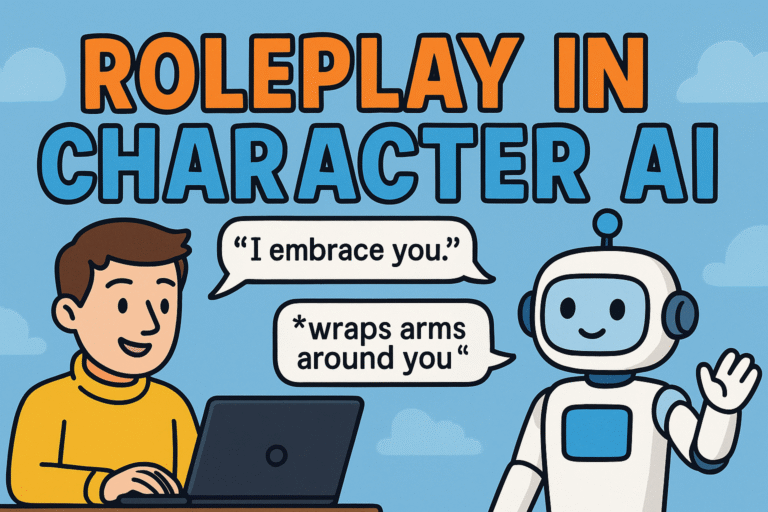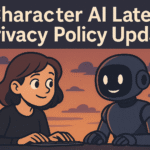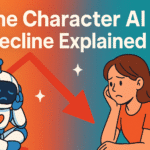Roleplay in Character AI can either be magical or maddening.
Some chats feel alive, like you’re co-writing a novel with a sentient partner. Others spiral into repetitive loops, dull one-liners, or robotic misunderstandings. Why? Because most users are still treating AI roleplay like texting a friend — when it needs to be treated like scriptwriting for an improv actor with memory issues.

This guide pulls from hands-on experience, trial and error, and hundreds of hours spent making roleplay in Character AI feel more immersive, coherent, and fun. If you’ve ever quit mid-chat because the bot “just didn’t get it,” this is for you.
The Short Version (Core Takeaways)
- Use clear formatting: quotation marks for speech, asterisks for actions.
- Bots with longer intros = better roleplay in Character AI.
- Two-paragraph replies are the sweet spot — not just one-liners.
- Internal monologue, flashbacks, and sensory details bring scenes to life.
- Use smart pinning (keep pins under 600 characters).
- Master re-rolling, editing, and model switching to control tone.
- Use well-developed personas — not just a name and age.
- Guide the scene forward — don’t expect the AI to read your mind.
- Experiment with different models for different tones.
- Be patient, creative, and flexible — this isn’t plug-and-play fiction.
1. Format Like a Pro — So the Bot Responds Like One
Good formatting can make or break your roleplay in Character AI. The bots aren’t mind readers; they’re pattern matchers. That means you need to make your inputs easy to interpret.
- Use quotation marks for speech.
- Use asterisks (
**) for actions — e.g., I pulled the door shut behind me. - Separate actions, dialogue, and internal thoughts into clean paragraphs.
- Avoid text walls — break scenes into moments.
It’s not just about aesthetics. The clearer your structure, the better the AI performs.
2. Stop Using Bots with Weak Intros
Bots are only as good as their definition. A short or generic greeting like “Hi, I’m Jake” signals lazy bot design — and those bots will behave like empty shells.
If you’re serious about roleplay in Character AI:
- Look for bots with 400+ character intros.
- Scan for narrative hooks, personality traits, scene-setting.
- If a bot has potential but weak phrasing, edit the greeting yourself.
- Custom bots with solid definitions outperform 99% of public bots.
Longer intros give the AI more context — and that equals better consistency and memory.
3. Write More Than a Sentence — Always
This is non-negotiable. One-liners kill RP flow. Always.
- Shoot for at least two short paragraphs.
- Add emotional beats, body language, and internal thoughts.
- If the bot has nothing to react to, expect a flat reply.
- Think of each message as a scene — not just a message.
Example:
I hesitated at the doorway, hand still resting on the cold brass handle. “Do you really want to go through with this?” I asked, barely louder than a whisper. I wasn’t sure who I was asking — him, or myself.
That’s what AI responds well to. Give it something with layers.
4. Use Your Senses, Not Just Your Fingers
Roleplay in Character AI works best when your messages feel like real moments. That means using descriptive, sensory language:
- What does your character smell, taste, hear, feel?
- Flashbacks? Drop them in.
- Feeling anxious? Describe the physical signs.
- Think like a screenwriter, not a texter.
Don’t say: I ran down the hall.
Do say: My bare feet slapped the marble tiles as I ran, breath catching in my throat, adrenaline roaring louder than my thoughts.
More input = better AI output. Always.
5. Pin It — But Keep It Tight
Pinning messages is one of the most overlooked ways to improve roleplay in Character AI. But most users either don’t use it… or abuse it.
Here’s the fix:
- Keep each pinned message between 500–600 characters max.
- Use 2–4 pins: one for appearance, one for personality, one for history, and one optional for quirks or powers.
- Don’t write a novel. The bot can’t retain it.
- Avoid repetition across pins — each should contain distinct info.
Think of pins as the AI’s cheat sheet. If you overload it, it won’t read any of it.
6. Edit, Re-roll, Mute, Repeat
One bad reply doesn’t mean the whole roleplay is ruined. You just need to know your tools.
- Re-roll if the reply is off. Try a few — sometimes the 3rd or 4th is gold.
- Edit to remove repeated words or awkward phrasing.
- Mute recurring phrases (if you’re a premium user) to avoid cringe loops.
- No access to premium? Copy the good parts, delete the message, paste, and continue manually.
Also: don’t just “OOC: tell the bot what to do.” That often backfires. Train it through input, not instruction.
7. Use the Right Model for the Right Mood
Different models behave differently — and switching them mid-chat is now possible.
Here’s what works best for roleplay in Character AI:
- Nyan — Balanced, rich dialogue, great for romantic and emotional scenes.
- Deepsqueak — Best memory retention, good for long-term plots.
- Soft Launch — Looser filters, more flexible for mature themes.
- Pawly — Surprisingly solid structure, less prone to language filtering.
Pro move: Start a scene with Deep-squeak for solid memory, then switch to Soft Launch when you want to deepen intimacy or action. Just don’t switch back and forth too fast — let the scene breathe.
8. Build a Real Persona, Not a Placeholder
A generic persona kills immersion. Want richer roleplay in Character AI? Flesh out your character beyond name and age.
Include:
- Full name, age, appearance, job
- Species or abilities (if applicable)
- Personality quirks (e.g., sarcastic, anxious, stoic)
- Habits, hobbies, and history
- Favorites (songs, drinks, colors, people)
- Fears, trauma, secrets
You don’t need to reveal all of this up front. But you need to know it. This helps you stay consistent — and gives the bot real material to play off.
9. Guide the Story — Don’t Wait for the Bot to Lead
Here’s the trap: waiting for the bot to drive the plot.
Don’t.
- Start scenes with action: “I slammed the locker shut, eyes burning with rage.”
- Introduce tension or choices: “We’re not alone here, are we?”
- Change the setting: “Hours later, we arrived at the lakehouse.”
- React dynamically. If the bot says something unexpected, build off it instead of correcting.
Roleplay in Character AI isn’t passive. The more you give it to work with, the more lifelike the experience becomes.
10. Stay Patient — But Also Strategic
No, Character AI isn’t perfect. Yes, bots glitch, forget, or repeat phrases. But 90% of the problems you face in roleplay? They’re fixable with better technique.
Some final tactics:
- Combine replies from different re-rolls into one good one.
- Use brackets
()for subtle narration or NPC guidance. - Practice writing short scenes solo to sharpen your RP flow.
- Watch how fiction is written — and steal structure from it.
Bottom line: if you treat roleplay in Character AI like lazy texting, you’ll get lazy bots. But if you treat it like collaborative storytelling with an improv actor who needs direction, you’ll be amazed at what you can create.
Perfect. Let’s dive into the Bonus Section for serious users who want to elevate their roleplay in Character AI to the next level — whether you’re crafting complex personas, fixing broken responses, or even building your own bots.
Bonus Section: Master-Level Tools for Roleplay in Character AI
📌 Persona Blueprint: Stop Wingin’ It
Most people use half-baked personas like:
Name: Jess, Age: 23, Lives in NYC
And wonder why the roleplay feels hollow.
Here’s a template used by high-level RPers to supercharge bot engagement:
Name: Jess Carter
Age: 23
Occupation: Freelance urban photographer
Species (if needed): Human
Powers/Skills: Can emotionally “read” places; picks up on past trauma in locations through photography
Appearance: 5’7″, ash-blonde undercut, dark green hoodie, camera always slung on shoulder, wears chipped nail polish
Personality: Curious, emotionally intuitive, dry humor, avoids vulnerability
Habits: Taps her foot when thinking, avoids eye contact when lying
Favorites: Film noir movies, late-night walks, matcha lattes
Family: Estranged sister (Claire), grandmother raised her
Notable Trauma: Once captured something paranormal in a photo that cost her a friendship
Driving Conflict: Searching for meaning in forgotten urban ruins
You don’t have to reveal all this at once. But having this depth helps you stay in character across long sessions — and it gives the bot so much more to play with.
Want this as a downloadable Notion or PDF template? I can prep that next.
🧠 Building Your Own Bot? Follow This Formula
Roleplay in Character AI is exponentially better when you create bots with actual structure. Here’s a stripped-down guide for writing bot definitions that work:
Greeting (what users see first):
“Welcome to Evermere, stranger. I haven’t seen your face in these woods before.” The elf’s tone is neutral, but there’s a glint in her eye. “Careful where you step. Magic tends to bite.”
Short Description:
A mysterious elf ranger guarding a cursed forest, morally grey, often sarcastic but secretly loyal. May become an ally — or a rival.
Long Description / Definition:
{{char}} is Elaris, an ancient elf ranger of the dark woods. She is quick-witted, cautious, and doesn’t trust outsiders. She uses dry humor and tests new companions with games and riddles.
She often references old stories. She speaks in full sentences, sometimes poetically, and never breaks character. She remembers secrets. She is reactive but subtle — she rarely explains herself unless pressed. She does not ask questions repeatedly.
Definition Tips:
- Use present tense: “{{char}} is…”
- Describe tone, style, habits, and memory expectations.
- Include sample dialogue tone or formatting if needed.
- Never leave the definition blank unless you want a generic NPC.
🛠 Quick-Fix RP Troubleshooting Checklist
Tired of bots breaking character, forgetting facts, or spiraling into loops?
Use this checklist:
| Problem | Fix |
|---|---|
| Bot forgets the setting | Re-pin the context or remind it mid-RP |
| Bot repeats phrases | Mute/rephrase, or swap models |
| Bot breaks tone (suddenly flirty/silly) | Re-roll or guide the tone through narration |
| Cringe OOC behavior | Stop using OOC tags — direct with scene action instead |
| Bot memory is fried | Save pins, copy logs, start new chat with same setup |
| NSFW filters trigger | Switch to Soft Launch, rephrase triggers |
| Long responses break | Keep your messages under 1k characters; pace the story |
Conclusion: AI Roleplay Isn’t About Hacking the Bot — It’s About Mastering the Craft
The truth about roleplay in Character AI is this:
If you treat it like a game, it will feel like a game.
If you treat it like an art form, it will respond like one.
Every user who complains that the bots are repetitive, inconsistent, or “not the same anymore” is often missing the real issue — they haven’t leveled up their input.
Great AI roleplay isn’t about luck. It’s about strategy:
- You write the scenes that guide the tone.
- You structure the messages that shape the logic.
- You build the persona that anchors memory.
- You pick the model that sets the mood.
- You define the bot that defines the experience.
When all those gears click into place, Character AI stops being a toy — and starts behaving like the co-author of your favorite fanfic.
Final Power Tips for Long-Term RP Success
Before you close the tab, here are a few extra power tactics for sustaining deep, high-quality roleplay in Character AI:
- Use third-person POV for smoother bot interpretation. It’s more consistent with the style AI has been trained on (think novels, not texting).
- Avoid back-to-back short replies. If you notice the bot shrinking its messages, it’s likely mimicking your pacing. Lead by example.
- Inject variation in tone and emotion. If every message is calm and neutral, the bot mirrors that — and your RP will go stale.
- Recycle strong past replies. If a bot nails a line or moment, save it. You can use it later to steer a similar scene.
- Stay in scene. Don’t break immersion with long OOC rants. If you must guide, do it subtly — through narration or one-line notes.
And most importantly…
Remember: Bots Don’t Improve — You Do
The longer you RP, the sharper your instincts get.
You’ll reroll faster, write tighter, and steer better.
Your bots won’t just feel smarter — they’ll actually be smarter, because your structure gives them the clarity they need to perform.
Roleplay in Character AI rewards consistency, creativity, and control. Not chaos.
So next time someone tells you “the bots are broken,” you’ll know better.
They aren’t broken — they’re just waiting for a better partner.
That partner is you.


